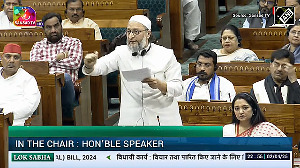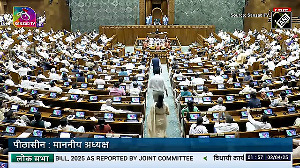 Dalal Street's romance with Srinagar-based Jammu & Kashmir Bank is proving to be a long-drawn one.
Dalal Street's romance with Srinagar-based Jammu & Kashmir Bank is proving to be a long-drawn one.
Tagged as a sleepy, regional lender till a few years earlier, the bank's stock was not much talked about in the investors' community.
Perhaps, the only curiosity regarding the bank was its plans to revive its two branches in Pakistan-occupied Kashmir.
Things have changed. The J&K Bank's stock price has risen 10 per cent since November 1 this year -- a period which saw the BSE Bankex go up 3.35 per cent.
The share price has more than doubled from its 52-week low of Rs 645.25 on December 15, 2011. The shares were traded at Rs 1,352 at the National Stock Exchange on Tuesday, up 2.5 per cent from the previous close.
What explains the market's love affair with J&K Bank, led by Mustaq Ahmed, who took over in October 2010?
Consider this: At a time banks are facing headwinds on the asset quality front, J&K Bank's net non-performing assets as on September-end stood stable at 0.16 per cent sequentially.
While its net NPA was one of the lowest in the industry, its provisioning coverage ratio was one of the highest, at 93 per cent.
While gross slippages was at 1.2 per cent, healthy recovery and cash recovery ensured gross NPA rise only marginally to two per cent.
"J&K Bank's asset quality continued to remain among the best in class," Kotak Securities said in a recent report.
The bank begun its much-delayed expansion plan in 2011-12, improved its earnings and kept the asset quality stable in the first half of this financial year.
Recently, it sold a part of its stake in MetLife for a profit of Rs 140-150 crore (Rs 1.4 to 1.5 billion).
This has made the bank's share attractive to investors, market analysts said.
"At the current market price, J&K Bank is trading reasonably at 1.15x FY14 ABV.
"We believe they deserve to get a better multiple, on the back of consistent performance on asset quality as well as strong return ratios over the last couple of years.
Its superior provision coverage ratio is icing on the cake and stands as one of the best in the industry (greater than 93 per cent, including technical write-offs), providing cushion to its future earnings, with any unforeseen deterioration in asset quality, going forward," said Saday Sinha, vice-president,
The legacy issues are also over, particularly with regard to capital.
There was a time when the Reserve Bank of India did not allow the bank to participate in the rights issue of Metlife, and asked J&K Bank to reduce its shareholding overtime.
Now, the banks sits on a 13.7 per cent capital adequacy ratio; and its chairman said in a recent interview to this paper that the bank would not require additional capital for at least three years.
In 2006, when the bank launched its new logo, the return on equity was 10 per cent while the return on assets was 0.7 per cent.
The efficiency parameters have improved since then, with RoE moving to 21 per cent and RoA to 1.5 per cent.
According to analysts, re-balancing its loan portfolio, with a better focus inside the state, has helped its margins.
"Earlier, the bank was mostly participating loan syndication outside the state, along with other bigger banks, which earned lower yields.
"Now, the bank is focusing more within the state, which improved the yield on advances," said an analyst with a domestic broking firm.
In addition, despite sluggish loan growth in the banking sector, J&K Bank is confident of achieving 25 per cent growth in the current financial year.
It has set a target of Rs 100,000 crore (Rs 1,000 billion) business volume and Rs 1,000 crore (Rs 10 billion) net profit by March 2013.
It closed the last financial year with net profit of Rs 803 crore (Rs 8.03 billion) and total business of Rs 86,424 crore (Rs 864.24 billion).
Broking firm Prabhudas Lilladher said the liability franchise of the bank was best among old generation private lenders. The bank's Casa ratio was 38 per cent in the July-September quarter.
"J&K Bank is most detached from the current economic slowdown and best positioned to benefit from a booming and under-penetrated Jammu & Kashmir state. . .
"The bank is more private than public sector bank," Prabhudas Lilladher said.
It added lack of management continuity is also absent in the bank, with five to six years of average tenure for the chairman.
The J&K government owns 53.17 per cent stake in the bank.












 © 2025
© 2025